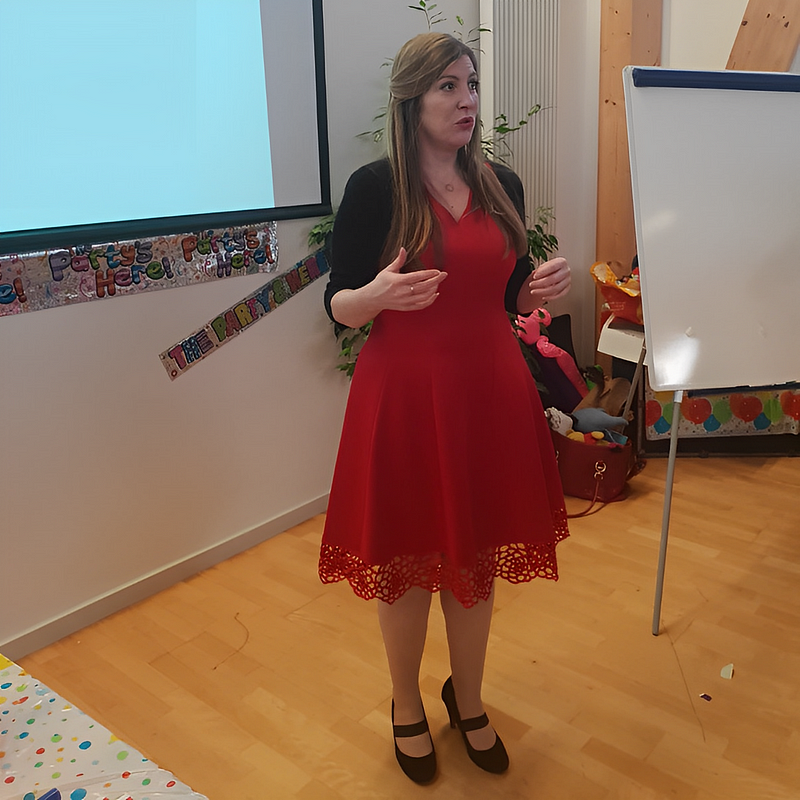Movement — taking some time every day to move my body, whether it’s getting outside for a walk, doing some yoga, or getting out for a swim.
Quiet quitting is the emerging phenomenon of employee disengagement, essentially quitting on the job. What strategies do high-impact leaders deploy to motivate themselves and those around them to move from quiet quitting to quiet committing? Because, at its core, there is no change without commitment. Commitment to change ideas. Change beliefs. Change perspectives. Change routines, rituals and boundaries. Organizations change one commitment at a time. One leader at a time. As part of our series about “Quiet Committing: The Top Five Commitments High Impact Leaders Make & Keep To Themselves Daily”, we had the pleasure of interviewing Aoife O’Brien.
Aoife O’Brien is the founder of Happier at Work, a business with the mission to eliminate toxic working environments for good. She is passionate about ‘fit’ and especially how creating the right environment can help organizations increase their bottom line while supporting individuals to reach their full potential at work. She works with business leaders and employees to focus on: workplace culture; cultivating balance; and empowering leaders. Aoife has been featured by several national media platforms and public speaking events talking about imposter syndrome, fit, employee engagement, productivity, and remote working. Her two-time award runner-up podcast, Happier at Work®, features a combination of interview-based episodes as well as solo podcasting, and has a global audience of nearly 80k. She has lived and worked in Dublin, London, Perth, and Sydney and has a BA in International Business and Languages (Spanish and German), an MSc in Work and Organizational Behavior, a Diploma in Executive and Life Coaching and a Certificate in Career Coaching.
Thank you for making time for our visit. What was the first job you had, and how did that job shape the leader you are today?
My first ever job was in a restaurant, and it taught me more about what not to do as a leader. It taught me the importance of making people feel like they belong, of giving clear instructions, and checking for understanding, as well as providing valuable feedback that people can act on.
We’re talking about quiet quitting in this series. What’s the greatest lesson you’ve learned from a job you decided to quit?
Two organizations stand out to me when asked that question. One of them was a completely toxic environment, the other was more of a cultural mis-fit. In both instances, it was a case of knowing I didn’t belong where I was and knowing that I had to do something about it. It highlighted to me the importance of knowing what your values are and being willing to take a stand for what you believe is right.
Employee Engagement is top of mind for most organizations. How do you define an engaged employee?
An engaged employee is someone who enjoys their work, knows how to leverage their strengths, has the company’s best interests in mind when making decisions. They are the employees who will go above and beyond in their work (sometimes to their own detriment, and this can lead to burnout).
Say more about your Employee Engagement portfolio. What’s working? What’s not working? And what are you piloting now to address the Quiet Committing trend?
Employee engagement is a key area of focus in the work I do with my corporate clients. I devised the Happier at Work framework, based on the research I did as part of my MSc in Organizational Behavior.
I look at three core pillars:
- Company culture, with a particular focus on values, whether they are true, being lived, and being recognized, and how they shape decisions in the organization.
- Finding balance through needs satisfaction and productivity levers — what is the ‘right’ work that needs to be done, and how do we ensure that employees psychological needs are being met and not thwarted through their work.
- Empowering leaders by understanding their own strengths and the strengths of their team, and how to leverage these strengths to make more better and more engaging for everyone.
As goes the leadership, so goes the team. How do you hold leaders accountable for their own level of engagement?
I was the leader who was disengaged at work, and I made the decision to leave because I was not in the right place to capitalize on my strengths. I think this is an important illustration of leading by example. You can’t ask people to do something you are not doing yourself, and I was not the right person to lead the team at that time. Upon reflection, I didn’t have the resources I needed to do the job effectively. Now, I ensure that leaders are clear on expectations, what “success” looks like, and make sure they have the resources necessary to carry out their role.
The first phase of the pandemic ushered in the phenomenon called The Great Resignation, where employees left organizations to pursue greater meaning and purpose. Then came The Great Reshuffle, where employees left organizations to pursue promotions, pay and perks. Now we’ve entered a third phase, Quiet Quitting, where employees are deeply disengaged. What do you believe to be the key drivers of Quiet Quitting?
I’ve heard people refer to ‘quiet quitting’ as checking out of your job, that you are doing the bare minimum just to get by, and enough not to be fired. On the other hand, I have heard of it as practicing better work/ life boundaries, which were really impacted because of the Covid-19 pandemic and people working from home. For me, the biggest drivers of this phenomenon are overwork and under-recognition. During the pandemic, a lot of workers were asked to take on extraordinary amounts of work, without necessarily having the resources to be able to do it and were not being recognized for their efforts.
What do you predict will be the next phase in the evolution of the employer / employee landscape?
The pandemic drove a change to how we work forever; there is no going back. I am currently working remotely from Tenerife in the Canary Islands (part of Spain, located off the coast of Africa). I have already seen a huge shift in how workers approach this and more and more people are taking advantage of the opportunity to work remotely. Another trend that I believe will come further down the line is work being organized by project-based work, where teams of people will be brought in to work on projects on behalf of organizations — I think we are still a long way away from this type of approach.
What leadership behaviors need to evolve to improve employee engagement in a sustainable way?
Often, leaders try to solve problems without truly understanding what the root cause is. The first step to improving employee engagement in a sustainable way is to listen to what’s going on in your organization rather than looking externally to what other organizations are doing. Asking employees the right questions to meet them where they are at.
Using a tool like the Happier at Work framework to address specific areas and know which levers to pull to increase employee engagement can also prove beneficial in driving retention, productivity, and engagement.

Change requires commitment and happens one choice at a time. What are the top five commitments you make and keep to yourself daily that have a material impact on those you lead?
1 . Movement — taking some time every day to move my body, whether it’s getting outside for a walk, doing some yoga, or getting out for a swim.
2 . Meditation — over the last number of years, I have learned the true power of meditation, simply by taking a few minutes out of an otherwise busy day to focus on the present, my breath, and trying to calm my mind.
3 . Reflection — this is something I often talk about on my podcast, the importance of taking time to ask yourself (and physically write down, don’t just think about it) what’s going well and what might you do differently tomorrow?
4 . Speaking up — this ties in with the idea of psychological safety mentioned above; it’s so important to create an environment where people feel safe to speak up and share what’s on their mind. As a leader, I need to lead by example, and speak up if I see something or want to challenge the status quo.
5 . Coaching — during my coaching studies, I learned the power of asking questions rather than telling people what they should do. Often, we have the answers within us, and by asking the right questions we can help employees feel empowered to find their own solutions.
What’s the most effective strategy you’ve discovered to get back on track when you break a commitment you’ve made?
Firstly, noticing that I am off track, and then treating this as a setback rather than a failure. When I prioritize these 5 areas, I know that I am putting myself first. But sometimes I get side-tracked or feel like I am “too busy” to get outside or spend 5 minutes meditating. Sometimes I realize sooner rather than later that this is what’s going on, but when I notice, I get back on track and the “busyness” seems to fall away.
Thank you for sharing these important insights. How can our readers further follow your work?
Feel free to check out my websites:
Connect on LinkedIn: https://www.linkedin.com/in/aoifemobrien
Hire me to speak!
Thank you for giving us the opportunity to experience a leadership master at work. We wish you continued success and good health!


